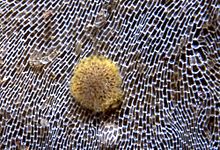- Crazed nudibranch
-
Crazed nudibranch Corambe sp. 
Scientific classification Kingdom: Animalia Phylum: Mollusca Class: Gastropoda (unranked): clade Heterobranchia
clade Euthyneura
clade Nudipleura
clade Nudibranchia
clade Euctenidiacea
clade DoridaceaSuperfamily: Onchidoridoidea Family: Corambidae Genus: Corambe Binomial name Corambe sp. The crazed nudibranch, Corambe sp., as designated by Gosliner, 1987, is a species of sea slug, a dorid nudibranch, a marine gastropod mollusc in the superfamily Onchidoridoidea.[1] It is also known as the moss animal nudibranch because its usual prey is a bryozoan, or moss animal. As at November 2009, it remained undescribed by science.
Contents
Distribution
This species is probably endemic to the South African coast and is found off the western shore of False Bay in 10-20 m of water.[2]
Description
The crazed nudibranch is a very small (less than 10mm) round nudibranch, which is extremely well camouflaged to match the bryozoan it preys on. Its rhinophores and gills are hardly visible and its body is covered with opaque lines.[3]
Ecology
The crazed nudibranch feeds on the rectangular membranous lace animal, Membranipora membranacea, which lives on broad bladed kelp. Its egg mass is a well camouflaged broad flat spiral.
References
- ^ Bouchet, P. & Rocroi, J.-P. (2005). "Classification and Nomenclator of Gastropod Families". Malacologia 47 (1-2).
- ^ Gosliner, T.M. (1987). Nudibranchs of Southern Africa ISBN 0-930118-13-8
- ^ Zsilavecz, G. (2007). Nudibranchs of the Cape Peninsula and False Bay. ISBN 0-620-38054-3
External links
Categories:- Corambidae
- Undescribed species
Wikimedia Foundation. 2010.
